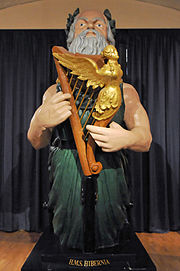HMS Hibernia (1804)

Figurehead of HMS Hibernia at the Malta Maritime Museum
|
|
| History | |
|---|---|
|
|
|
| Name: | HMS Hibernia |
| Ordered: | 9 December 1790 |
| Builder: | Plymouth dockyard |
| Laid down: | November 1797 |
| Launched: | 17 November 1804 |
| Fate: | Sold 1902 |
| General characteristics | |
| Class and type: | 110-gun first rate ship of the line |
| Tons burthen: | 2530 (bm) |
| Length: | 201 ft 2 in (61.32 m) (gundeck) |
| Beam: | 53 ft 1 in (16.18 m) |
| Depth of hold: | 22 ft 4 in (6.81 m) |
| Propulsion: | Sails |
| Sail plan: | Full rigged ship |
| Armament: |
|
HMS Hibernia was a 110-gun first rate ship of the line of the Royal Navy. She was launched at Plymouth dockyard on 17 November 1804, and was the only ship built to her draught, designed by Sir John Henslow.
Between 1807 and 1808, Hibernia, under the command of Sir William Sidney Smith, led the British escort of the Portuguese Royal Family during the transfer of the Portuguese Court to Brazil.
Hibernia was flagship of the British Mediterranean Fleet from 1816 until 1855, when she became the flagship for the Royal Navy's base at Malta and stationed in Grand Harbour. She remained in this role until she was sold in 1902.
After the Napoleonic Wars ended in 1815, HMS Hibernia was used in the service of the British Empire in other ways, such as to transport convicts to the colony of New South Wales. In 1818-1819, for example, the ship carried 160 male convicts to Sydney from Portsmouth sailing on 20 November and arriving 18 June. Also on board as passengers were the first Minister of St James' Church, Sydney, Richard Hill and his wife.
The ten-day court-martial of the surviving officers and crewmen of the battleship HMS Victoria for the loss of their ship in a 22 June 1893 collision with the battleship HMS Camperdown was held on Hibernia's deck. The proceedings began on 17 July 1893.
...
Wikipedia
